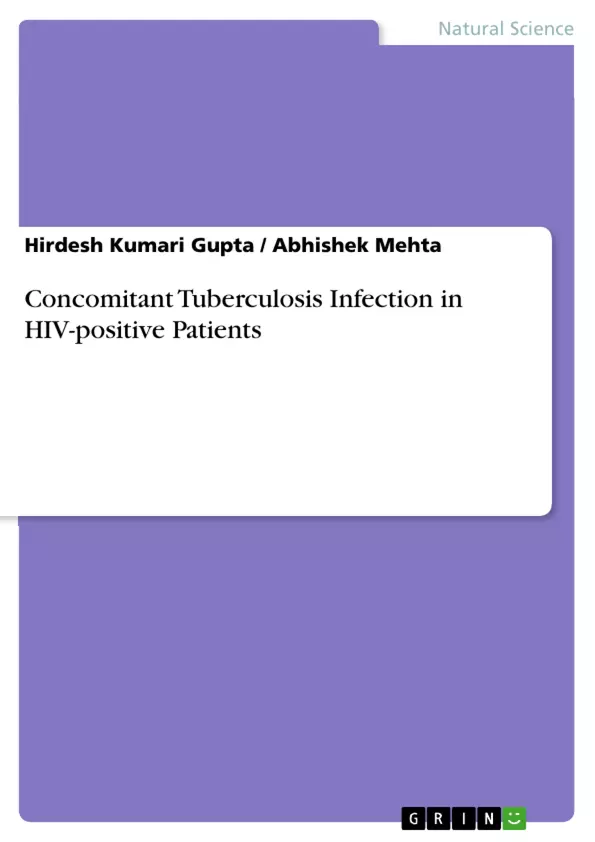Mycobacterium tuberculosis (TB) and human immune deficiency virus (HIV) infections are two major public health problems in many parts of the world, particularly in many developing countries. TB is the most common opportunistic disease and cause of the death for those infected with HIV. Diagnosis of TB in HIV infected patients may be delayed because of atypical clinical presentation and involvement of inaccessible sites and low sputum smear positivity. Further, there has been an increase in rates of drug resistant tuberculosis, including multi-drug (MDR-TB) and extensively drug resistant TB (XDR-TB), which are difficult to treat and contribute to increased morbidity and mortality.
TB is the most common serious opportunistic infection in HIV positive patients and is the manifestation of AIDS in more than 50% of cases in developing countries. TB shortens the survival of patients afflicted with HIV infection, may accelerate the progression of HIV, and is the cause of death in one third of people with AIDS worldwide. While HIV and TB can individually be the major causes for public health threats, the combination of the two has proven to have a far greater impact on the epidemiologic progression and consequently on the global health scene.
Although the increased access to highly active antiretroviral therapy (HAART) has led to a reduction in HIV-associated opportunistic infections and hence mortality, but the concurrent management of HIV/TB co-infection remains a serious challenge to the health care delivery system. Discussion on the mechanisms produced by infectious cofactors with impact on disease pathology could shed light on how to design potential interventions that could decelerate disease progression. It is the need of the hour to design strategies against HIV-TB co-infection.
This book is based on my PG thesis work in Medical Microbiology written long bank, but in the current scenario the topic of TB-HIV co-infections holds relevance and is currently a burning issue. This has motivated me to convert my thesis in the form of a Book. The knowledge particularly in the field of medical sciences should not be restricted just to earn a University degree but should be disseminated in the entire scientific community so that medical fraternity including teachers, students, doctors, paramedics, researchers and above all the patients are benefitted. I am thankful to publications for giving me an opportunity to fulfil this dream.
Inhaltsverzeichnis (Table of Contents)
- Introduction
- Aims and Objectives
- Review of Literature
- Materials and Methods
- Results
- Summary and Conclusion
- Bibliography
- Abbreviations
- Author Biosketch
Zielsetzung und Themenschwerpunkte (Objectives and Key Themes)
This book provides a comprehensive exploration of concomitant tuberculosis infection in HIV-positive patients, emphasizing the significance of this co-infection as a major public health concern, particularly in developing countries. It delves into the complexities of diagnosis, treatment, and prevention of TB in individuals living with HIV. The book also sheds light on the impact of highly active antiretroviral therapy (HAART) on the management of HIV/TB co-infection.
- Epidemiology and global burden of TB-HIV co-infection
- Challenges in diagnosis and treatment of TB in HIV-infected patients
- Impact of drug resistance on TB treatment outcomes
- Role of HAART in managing HIV/TB co-infection
- Strategies for preventing and controlling TB-HIV co-infection
Zusammenfassung der Kapitel (Chapter Summaries)
- Introduction: This chapter provides an overview of tuberculosis (TB) and human immunodeficiency virus (HIV) infections, highlighting their individual and combined impacts on global health. The historical context of TB research is explored, along with the epidemiology of TB and its impact on HIV-positive individuals.
- Aims and Objectives: This chapter outlines the specific goals and research objectives of the book, focusing on understanding the complexities of TB-HIV co-infection and developing strategies for effective management.
- Review of Literature: This chapter presents a comprehensive review of existing literature on TB-HIV co-infection, covering various aspects such as epidemiology, pathogenesis, diagnosis, treatment, and prevention. This section provides a foundation for understanding the current state of knowledge in this field.
- Materials and Methods: This chapter describes the research methods employed in the study, including the study design, population, data collection techniques, and analytical approaches used to investigate TB-HIV co-infection.
Schlüsselwörter (Keywords)
The book primarily focuses on the following key terms and concepts: tuberculosis (TB), human immunodeficiency virus (HIV), co-infection, epidemiology, pathogenesis, diagnosis, treatment, drug resistance, highly active antiretroviral therapy (HAART), public health, developing countries, global health, opportunistic infections, and mortality.
- Quote paper
- Hirdesh Kumari Gupta (Author), Abhishek Mehta (Author), 2015, Concomitant Tuberculosis Infection in HIV-positive Patients, Munich, GRIN Verlag, https://www.grin.com/document/1306132



